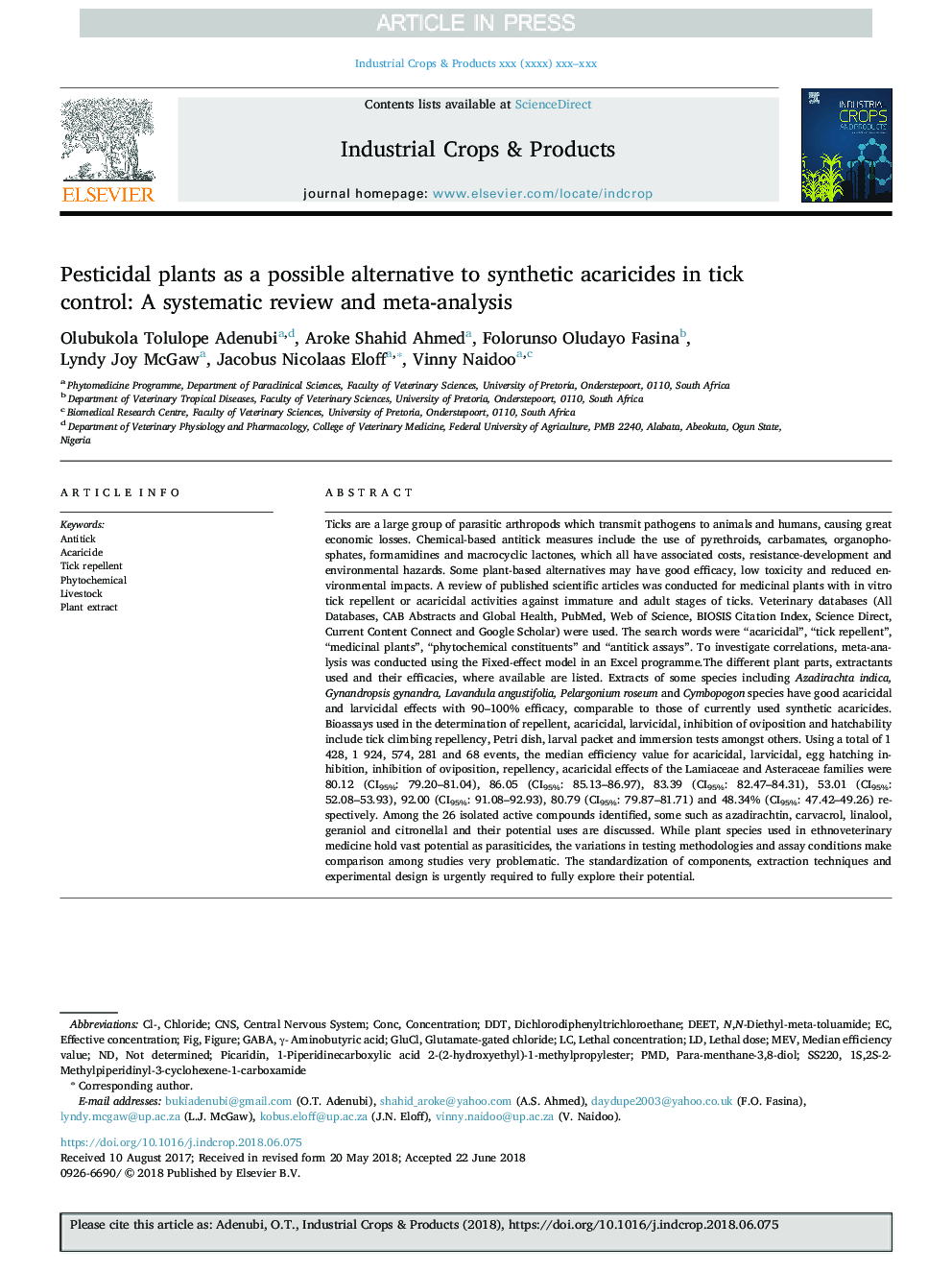| کد مقاله | کد نشریه | سال انتشار | مقاله انگلیسی | نسخه تمام متن |
|---|---|---|---|---|
| 10117028 | 1624787 | 2018 | 28 صفحه PDF | دانلود رایگان |
عنوان انگلیسی مقاله ISI
Pesticidal plants as a possible alternative to synthetic acaricides in tick control: A systematic review and meta-analysis
ترجمه فارسی عنوان
گیاهان پتاسیم به عنوان یک جایگزین برای آکریاریدهای مصنوعی در کنترل قارچ: یک بررسی سیستماتیک و متا آنالیز
دانلود مقاله + سفارش ترجمه
دانلود مقاله ISI انگلیسی
رایگان برای ایرانیان
کلمات کلیدی
dichlorodiphenyltrichloroethaneN,N-diethyl-meta-toluamideCl-GluClAcaricideMEVDEETPMd - PMDLivestock - دام (حیوان)CNS - دستگاه عصبی مرکزیlethal dose - دوز مرگبارDDT - دیکرو دیفنیل تری کلرواتانcentral nervous system - سیستم عصبی مرکزیFig - شکلfigure - شکلPlant extract - عصاره گیاهیconcentration - غلظت effective concentration - غلظت موثرlethal concentration - غلظت کشندهPhytochemical - فیتوشیمیاییnot determined - مشخص نشدهChloride - کلریدConc - کنGABA - گابا
موضوعات مرتبط
علوم زیستی و بیوفناوری
علوم کشاورزی و بیولوژیک
علوم زراعت و اصلاح نباتات
چکیده انگلیسی
Ticks are a large group of parasitic arthropods which transmit pathogens to animals and humans, causing great economic losses. Chemical-based antitick measures include the use of pyrethroids, carbamates, organophosphates, formamidines and macrocyclic lactones, which all have associated costs, resistance-development and environmental hazards. Some plant-based alternatives may have good efficacy, low toxicity and reduced environmental impacts. A review of published scientific articles was conducted for medicinal plants with in vitro tick repellent or acaricidal activities against immature and adult stages of ticks. Veterinary databases (All Databases, CAB s and Global Health, PubMed, Web of Science, BIOSIS Citation Index, Science Direct, Current Content Connect and Google Scholar) were used. The search words were “acaricidal”, “tick repellent”, “medicinal plants”, “phytochemical constituents” and “antitick assays”. To investigate correlations, meta-analysis was conducted using the Fixed-effect model in an Excel programme.The different plant parts, extractants used and their efficacies, where available are listed. Extracts of some species including Azadirachta indica, Gynandropsis gynandra, Lavandula angustifolia, Pelargonium roseum and Cymbopogon species have good acaricidal and larvicidal effects with 90-100% efficacy, comparable to those of currently used synthetic acaricides. Bioassays used in the determination of repellent, acaricidal, larvicidal, inhibition of oviposition and hatchability include tick climbing repellency, Petri dish, larval packet and immersion tests amongst others. Using a total of 1 428, 1 924, 574, 281 and 68 events, the median efficiency value for acaricidal, larvicidal, egg hatching inhibition, inhibition of oviposition, repellency, acaricidal effects of the Lamiaceae and Asteraceae families were 80.12 (CI95%: 79.20-81.04), 86.05 (CI95%: 85.13-86.97), 83.39 (CI95%: 82.47-84.31), 53.01 (CI95%: 52.08-53.93), 92.00 (CI95%: 91.08-92.93), 80.79 (CI95%: 79.87-81.71) and 48.34% (CI95%: 47.42-49.26) respectively. Among the 26 isolated active compounds identified, some such as azadirachtin, carvacrol, linalool, geraniol and citronellal and their potential uses are discussed. While plant species used in ethnoveterinary medicine hold vast potential as parasiticides, the variations in testing methodologies and assay conditions make comparison among studies very problematic. The standardization of components, extraction techniques and experimental design is urgently required to fully explore their potential.
ناشر
Database: Elsevier - ScienceDirect (ساینس دایرکت)
Journal: Industrial Crops and Products - Volume 123, 1 November 2018, Pages 779-806
Journal: Industrial Crops and Products - Volume 123, 1 November 2018, Pages 779-806
نویسندگان
Olubukola Tolulope Adenubi, Aroke Shahid Ahmed, Folorunso Oludayo Fasina, Lyndy Joy McGaw, Jacobus Nicolaas Eloff, Vinny Naidoo,
